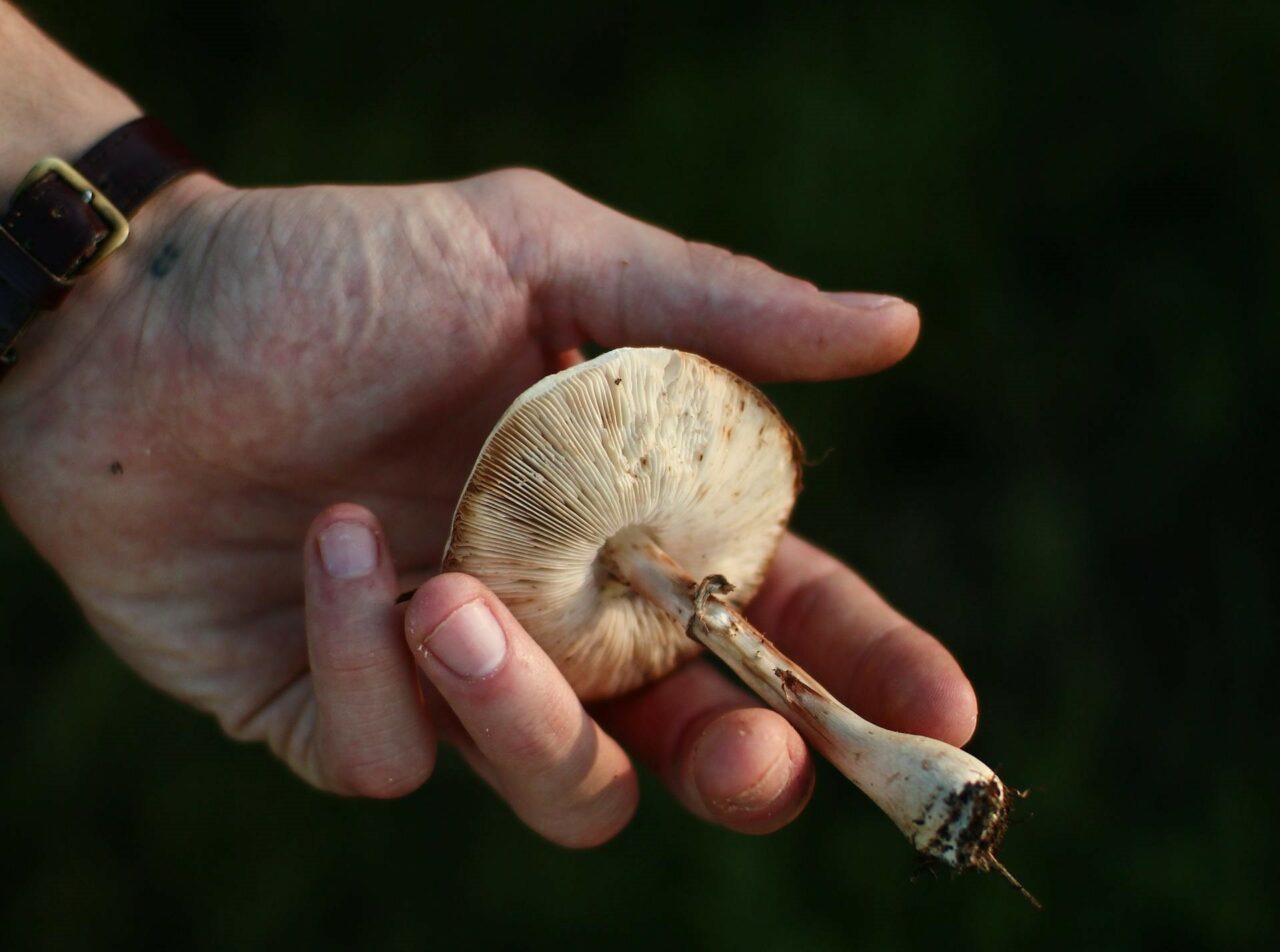Psilocybin mushrooms, traditionally known as a psychedelic, function as a serotonin 5-HT2A receptor agonist, similar to LSD. Currently, they are under research for their potential in psilocybin-assisted therapy to treat mental health disorders. These disorders include major depression, anxiety, emotional distress, cluster headaches, and migraines.
Understanding how shrooms can help with these conditions requires studying how they are metabolized in the human body. This knowledge enables both researchers and users to comprehend how the active compound produces psychological and therapeutic effects. This article serves as a basic guide to the pharmacology and pharmacokinetics of psilocybin.
[toc]
Key Takeaways:
- Once consumed orally, half of the psychedelic fungi are absorbed and dispersed throughout the body.
- The compound within the fungi undergoes dephosphorylation through the enzyme alkaline phosphatase, primarily within the liver.
- Approximately 3.4% of the compound is excreted in its original form within a day, with the majority being expelled as a stable metabolite.
What Does Pharmacokinetics Mean?
Pharmacokinetics (PK) is a field of study that examines how substances, such as drugs, are processed in the body after intake. While it is closely related to pharmacodynamics, which focuses on how a compound interacts with the body, PK primarily concerns four main aspects: absorption, distribution, metabolism, and excretion (ADME).
Being aware of these processes allows health professionals to prescribe the most effective medication with the least risk. Furthermore, it provides them with the ability to customize treatments based on individual physiology and lifestyle.
How Does Pharmacokinetics Relate to Psilocybin?
Psilocybin and psilocin, the primary active compounds in certain magic mushroom species, have attracted significant attention from researchers and consumers. Pharmacokinetics explores how the body processes these psilocybin-containing mushrooms and helps elucidate their potential effects, be it medicinal or recreational.
These compounds are referred to by various names, including “magic,” “psychedelic,” “medicinal,” or “sacred.” The fungi that hold these compounds are consumed, with The Various mushroom species, their origins, size, cultivation and drying conditions, and age can cause substantial fluctuations in their concentration levels.
While these mushrooms can naturally be found in the wild, scientists have devised ways to artificially produce them in labs. Both the naturally occurring and lab-produced varieties exhibit low toxicity, though some minor side effects such as nausea or vomiting may present themselves.
Despite the potential physical side effects, the compounds within these mushrooms have demonstrated promising therapeutic benefits due to their safety profile and non-addictive properties. This has led researchers to explore their application in psychotherapeutic treatment, particularly for conditions such as anxiety and depression.
The 4 Stages of Pharmacokinetics
Psilocybin, a compound found in these mushrooms, is inactive in its raw form and acts as a prodrug. It undergoes transformation into psilocin, the active form, with the assistance of enzymes like alkaline phosphatase. This conversion allows psilocin to be absorbed and distributed across the body, reaching various tissues. However, post-oral administration, psilocybin is undetectable in circulation, fecal matter, or urine.
Absorption
Absorption refers to the process where the compound enters the bloodstream from its point of administration. This process dictates the rate and effectiveness at which the compound arrives at its target, such as plasma. Oral administration is the most commonly used method, while inhalation has been attempted but proven less effective.
The absorption process also encompasses the release of the compound from the dosage form during oral ingestion. Elements such as a delay in the throat or esophagus can affect this, potentially delaying results or leading to irritation. Once the compound reaches the stomach, it may start breaking down due to the acidic environment before it enters the bloodstream.
Studies on animals suggest that only about 50% of orally administered psychedelics are absorbed and distributed within the body.
Factors Influencing the Absorption Process
Several aspects can influence the absorption process, leading to variations in onset, intensity, and duration:
- Stomach Contents: Consuming the compound on a full stomach can delay the process as it slows down the onset of effects. An empty stomach allows for quicker absorption.
- Body Fat: Compounds have the ability to amass in fat tissues, potentially prolonging their effects.
- Age: Metabolic rates and body composition are subject to changes with age.
- Zero-Order Kinetics: The substance is eliminated at a consistent rate, regardless of its concentration.
- First-Order Kinetics: The elimination rate is linearly related to the concentration of the drug.
This process is significantly impacted by factors like the product’s size, polarity, protein-binding capacity, as well as the individual’s physical characteristics, such as hydration status and body composition.
The aim is to achieve an effective concentration at the intended location. For a product to be effective, it needs to reach the target site as determined by the volume of distribution, and remain unattached to proteins, which allows it to actively interact with its receptor.
What Factors Influence Distribution Processes?
Several elements can affect the distribution process:
Effects typically begin to manifest between 20-40 minutes after intake, peaking around 80-100 minutes. The effects of magic mushrooms generally persist for 4-6 hours.
How Does Distribution to the Brain Happen?
Initial studies on two species demonstrated that the binding affinity sequence is 5HT2A > 5HT1A > 5HT2B [23]. It also latches on to dopamine D1, 5HT1E, 5HT5A, 5HT7, 5HT6, D3, 5HT2C, and 5HT1B receptors.
It acts as a partial agonist at the 5HT2A receptor, with roughly 40% efficacy. Its psychedelic effects are believed to be due to its partial agonist activity at 5HT1A autoreceptors.
The mood-elevating and psychotomimetic experiences may stem from the observed link between increased dopamine levels and sensations of depersonalization and euphoria. Hallucinogens work by modifying neurochemistry and receptor function. It enhances 5HT2A agonist activity by augmenting BDNF synthesis in the hippocampus, which promotes neurogenesis and reduces conditioned fear-related behaviors.
Elimination
Elimination refers to the process through which the The human body disposes of substances through several means – primarily the kidneys, but also the lungs, skin, and gastrointestinal tract. In terms of the kidneys, a naturally-occurring hallucinogenic drug is either filtered at the glomerulus or secreted in the tubules, with a measure of reabsorption contributing to the complexity of this process.
The primary component has a half-life of around 160 minutes, whereas the half-life of psilocin is roughly 50 minutes. Animal research indicates that most of this substance is excreted through the urine, making up about 65% within 8 hours of consumption. Smaller amounts of the substance can be traced in the bile and feces.
In the human body, about 3.4% of this substance is expelled in its original form within 24 hours. However, most of it is eliminated as psilocin-O-glucuronide, which is a more stable metabolite. This stability allows the detection of the compound in urine samples over a prolonged period.
There exist two primary methods of substance elimination:
The majority of psychedelic drugs follow the first-order kinetics method, reaching stable concentrations after four to five half-lives. Complete elimination also occurs after four to five half-lives.
Discover Our Variety of Psychedelic Mushrooms
The metabolic process can differ between various types of mushrooms. By purchasing from trusted online vendors like Fungalfriend Canada, you can prevent unintentionally consuming poisonous mushrooms. Certain varieties, like Agaric mushrooms, can yield strong and potentially unpleasant effects. Hence, it’s essential to procure magic mushrooms from credible sources, instead of taking risks with street vendors or wild foraging.
| Attribute | Enigma | Full Moon Party | Gold Member | |
| Strain Type | Psilocybe Cubensis OMNI | Psilocybe cubensis (Thai Koh Samui) | Psilocybe cubensis | |
| Strength | Extraordinarily high; 3.8% tryptamine content | Moderately to highly potent | Highly potent | |
| Visual Features | Resembles a blob or | Resembles a cauliflower or brain structure | Displays the typical appearance of a cubensis; moderately sized | Features thick white stems, golden caramel caps, and noticeable blue bruising |
| Effects | Considered the most potent; generates intense effects | Produces a strong mental high; has a delayed onset with notable visuals | Offers potent visuals and euphoria |
Expand Your Knowledge of Psilocybin Mushroom Usage Online
For medical professionals, researchers, and consumers, comprehending the pharmacokinetics of shrooms is crucial. This understanding allows you to make informed decisions regarding dosage and timing, thus reducing potential risks.
Discover your perfect psychedelic experience at Fungalfriend Canada. Whether you’re in search of a soothing journey or a deeper exploration, our wide range of products is designed to meet your individual needs. Enjoy high-quality, safe, and regulated shrooms, eliminating worries about dubious sources or poisonous mushrooms.
Immerse yourself in the best magic mushrooms Canada can provide, and elevate your psychedelic adventure to new heights.
Frequently Asked Questions
Do shrooms interact with other medications?
Our products may interact with certain medications, particularly those impacting serotonin levels, such as SSRIs (Selective Serotonin Reuptake Inhibitors). SSRIs and SNRIs (Serotonin and Norepinephrine Reuptake Inhibitors) tend to reduce the effects, unlike non-serotonergic antidepressants. This reduced effect can last for up to three months after stopping the antidepressant.
Do all psychedelics operate in the same way as psilocybin?
No, each psychedelic substance has a unique structure that requires different metabolic processes to activate, and they bind to various receptors in the body. The mode of administration also affects the absorption of each psychedelic. While the basic principles of absorption, metabolism, and distribution stay the same, the specific pathways and effects vary for each substance.
Does the form of the mushroom affect pharmacokinetics?
Yes, the mushroom’s form (whether fresh, powdered, or dried) can influence the absorption rate. For example, powdered versions may be absorbed faster than whole dried ones due to quicker dissolution.
Further Reading:





